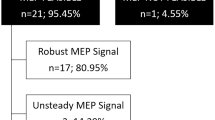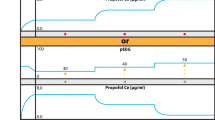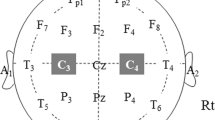Summary
Motor evoked potentials (MEPs), monitoring the motor function directly, are superior to somatosensory evoked potentials (SSEPs) in monitoring the motor system during spinal surgery. Reliable MEPs are difficult to elicit under normal anaesthesia. Using intravenous anaesthesia with either ketamine or etomidate infusion, we performed intraoperative MEP monitoring in 12 spinal operations for 11 cases from February 1992 to May 1992. For anaesthesia, ketamine was used in 5, etomidate in 7, fentanyl was supplemented in all, muscle relaxation at 30% to 50% of pre-anaesthetic muscle power was maintained with atracurium or vencuronium infusion. Transcranial bipolar electrical stimulation was used to induce MEPs. Concomitant SSEP monitoring was performed in 3. No significant anaesthesia related side effects were noted except one episode of unpleasant dream occurred in the ketamine anaesthesia group.
Successful monitoring was achieved in 10 sessions. In 5 of which warning to the surgeons was made due to sudden MEP deterioration, which recovered followed by definite management in four and persisted in one. In the other 5 sessions, no warning was made due to stationary or gradual change in MEPs. Bilateral two-channel recordings were used in 3 sessions. In 2 of which unilateral transient change was noted. Loss of SSEPs was noted in one despite unchanged MEPs, in whom only new sensory deficits occurred postoperatively. Compared to the baseline MEPs in terms of latency and amplitude, the final MEPs improved in 5 sessions, did not change significantly in 4 sessions, deteriorated in one session, and were correlated well with the immediate postoperative motor status.
In our small series, the intraoperative MEP monitoring showed neither false negative nor false positive result. It is concluded that the intraoperative MEP monitoring is feasible under intravenous ketamine or etomidate anaesthesia and valuable in spinal surgery.
Similar content being viewed by others
References
Agnew WF, McCreery DB (1987) Considerations for safety in the use of extracranial stimulation for motor evoked potentials. Neurosurgery 20: 143–147
Barker AT, Jalinous R, Freeston IL, Jarratt JA (1985) Motor responses to noninvasive brain stimulation in clinical practice. Electroencephalogr Clin Neurophysiol 61: 570
Barker AT, Freeston IL, Jalinous R, Jarratt JA (1987) Magnetic stimulation of the human brain and peripheral nervous system: an introduction and the results of an initial clinical evaluation. Neurosurgery 20: 100–109
Ben-David B, Haller G, Taylor P (1987) Anterior spinal fusion complicated by paraplegia: a case report of a false-negative somatosensory-evoked potential. Spine 12: 536–539
Boyd SG, Rothwell JC, Cowan JMA,et al (1986) A method of monitoring function in corticospinal pathways during scoliosis surgery with a note on motor conduction velocities. J Neurol Neurosurg Psychiatry 49: 251–257
Calancie B, Klose KJ, Baier S, Green BA (1991) Isoflurane-induced attenuation of motor evoked potentials caused by electrical motor cortex stimulation during surgery. J Neurosurg 74: 897–904
Chang CW, Lien IN (1991) Estimation of normal motor conduction velocity of spinal cord by using transcranial electric stimulation and F-wave study. Electromyogr Clin Neurophysiol 31: 47–52
Dubin S, Yodlowski E (1988) Effect of halothane on motor evoked potentials. Anesthesiology 69: A605 (abstract)
Ducker TB, Salcman M, Lucas JT, Garrison WB, Perot PL (1978) Experimental spinal cord trauma. II: blood flow, tissue oxygen, evoked potentials in both paretic and plegic monkeys. Surg Neurol 10: 66–72
Friedman WA, Curran MT (1987) Somatosensory evoked potentials after sequential extremity stimulation: a new method for improved monitoring accuracy. Neurosurgery: 21: 755–758
Ghaly RF, Stone JL, Aldrete A, Levy WJ (1990) Effects of incremental ketamine hydrochloride doses on motor evoked potentials (MEPs) following transcranial magnetic stimulation: a primate study. J Neurosurg Anes 2: 79–85
Ghaly RF, Stone JL Levy WJ, Roccaforte P, Brunner EB (1990) The effect of etomidate on motor evoked potentials induced by transcranial magnetic stimulation in the monkey. Neurosurgery 27: 936–942
Ginsburg HH, Shelter AG, Raudzens PA (1985) Postoperative paraplegia with preserved intraoperative somatosensory evoked potentials: case report. J Neurosurg 63: 293–300
Gualtierotti T, Paterson AS (1954) Electrical stimulation of the unexposed cerebral cortex. J Physiol 125: 278–291
Haghighi SS, Green KD, Oro JJ, Drake RK, Kracke GR (1990) Depressive effect of isoflurane anesthesia on motor evoked potentials. Neurosurgery 26: 993–997
Jellinek D, Jewkes D, Symon L (1991) Noninvasive intraoperative monitoring of motor evoked potentials under propofol anesthesia: effects of spinal surgery on the amplitude and latency of motor evoked potentials. Neurosurgery 29: 551–557
Kalkman CJ, Drummond JC, Ribberrink AA, Patel PM, Sano T, Bickford RG (1992) Effects of propofol, etomidate, midazolam, and fentanyl on motor evoked responses to transcranial electrical or magnetic stimulation in humans. Anesthesiology 76: 502–509
Kitagawa H, Itoh T, Takano H, Takakuwa K, Yamamoto N, Yamada H, Tsuji H (1989) Motor evoked potential monitoring during upper cervical spine surgery. Spine 14: 1078–1083
Konrad PE, Tacker WA, Levy WJ, Reedy P, Cook JR, Geddes LA (1987) Motor evoked potentials in the dog: effect of global ischemia on spinal cord and peripheral nerve signals. Neurosurgery 20: 117–124
Lesser RP, Raudzens P, Luders H,et al (1986) Postoperative neurological deficits may occur despite unchanged intraoperative somatosensory evoked potentials. Ann Neurol 19: 22–25
Levy WJ, York D, McCaffery M, Tanzer F (1984) Motor evoked potentials from transcranial stimulation of the motor cortex in humans. Neurosurgery 15: 287–302
Levy WJ (1987) Clinical experience with motor and cerebellar potentials monitoring. Neurosurgery 20: 169–182
Levy WJ (1983) Spinal evoked potentials from the motor tract. J Neurosurg 58: 38–44
Loughnan BA, Anderson SK, Hetreed MA, Weston PF, Boyd SG (1989) Effects of halothane on motor evoked potential recorded in the extradural space. Br J Anaesth 63: 561–564
Merton PA, Morton HB (1980) Stimulation of the cerebral cortex in the intact subject. Nature (Lond) 285: 227
Mills KR, Murray NMF, Hess CW (1987) Magnetic and electrical transcranial stimulation: physiological mechanisms and clinical applications. Neurosurgery 20: 164–168
Owen JH, Bridwell KH, Grubb R, Jenny A, Allen B, Padberg AM, Shimon SM (1991) The clinical application of neurogenic motor evoked potentials to monitor spinal cord function during surgery. Spine 16 [Suppl]: S 385-S 390
Rosenberg JN (1992) Somatosensory and magnetic evoked potentials in a postoperative paraparetic patient: case report. Arch Phys Med Rehab 72: 154–156
Rossini PM, Marciani MG, Caramia M, Roma V, Zarola F (1985) Nervous propagation along “central” motor pathways in intact brain: characteristics of motor responses to “bifocal” and “unifocal” spine and scalp non-invasive stimulation. Electroencephalogr Clin Neurophysiol 61: 272–278
Tung H, Drummond JC, Bickford R (1988) The effects of anesthetic and sedative agents on magnetic motor evoked potentials. Anesthesiology 69 [Suppl 3 a]: A 313 (abstract)
York DH, Watts C, Raffensberger M, Spagnolia T, Joyce C (1983) Utilization of somatosensory evoked potentials in spinal cord injury: prognostic limitations. Spine 8: 832–839
Zentner J, Ebner A (1989) Nitrous oxide suppresses the electromyographic response evoked by the electrical stimulation of the motor cortex. Neurosurgery 24: 60–62
Zentner J, Kiss I, Ebner A (1989) Influence of anaesthetics-nitrous oxide in particular-on electromyographic response evoked by transcranial electrical stimulation of the cortex. Neurosurgery 24: 253–256
Zentner J (1989) Noninvasive motor evoked potential monitoring during neurosurgical operations on the spinal cord. Neurosurgery 24: 709–712
Zentner J (1991) Motor evoked potential monitoring during neurosurgical operations on the spinal cord. Neurosurg Rev 14: 29–36
Author information
Authors and Affiliations
Rights and permissions
About this article
Cite this article
Yang, L.H., Lin, S.M., Lee, W.Y. et al. Intraoperative transcranial electrical motor evoked potential monitoring during spinal surgery under intravenous ketamine or etomidate anaesthesia. Acta neurochir 127, 191–198 (1994). https://doi.org/10.1007/BF01808765
Issue Date:
DOI: https://doi.org/10.1007/BF01808765




